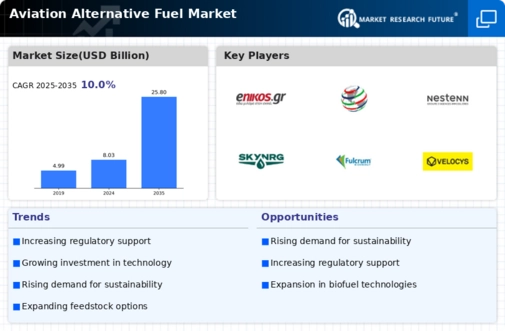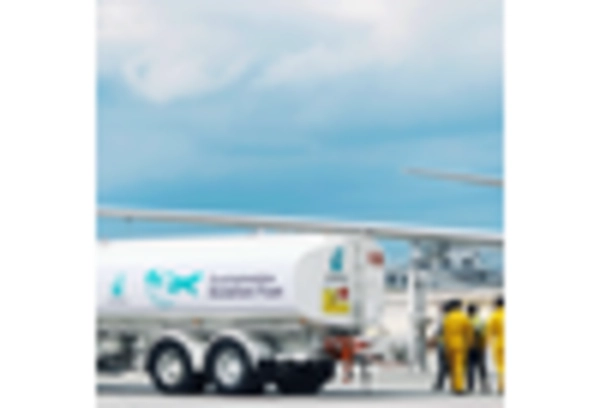-
Executive Summary
-
Market Attractiveness Analysis
- Global Aviation Alternative Fuel Market, by Process
- Global
-
Aviation Alternative Fuel Market, by Fuel Type
-
Global Aviation Alternative
-
Fuel Market, by Application
-
by Region
-
Global Aviation Alternative Fuel Market,
-
Market Introduction
-
Market Definition
-
Scope
-
of the Study
-
Market Structure
-
Key Buying Criteria
-
Market Factor Indicator Analysis
-
Research Methodology
-
Research
-
Process
-
Primary Research
-
Secondary Research
-
Market
-
Size Estimation
-
Forecast Model
-
List of Assumptions
-
Market
-
Insights
-
Market Dynamics
-
Introduction
-
Drivers
-
Restraints
-
Opportunities
-
Challenges
-
Market/Technological
-
Trends
-
Patent Trends
-
Regulatory Landscape/Standards
-
Market Factor Analysis
-
Value Chain/Supply Chain Analysis
- R&D
- Manufacturing
- Distribution & Sales
- Post-Sales
-
Monitoring
-
Porter’s Five Forces Analysis
- Threat of New
- Bargaining Power of Buyers
- Threat of Substitutes
- Intensity of Rivalry
- Bargaining Power of Suppliers
-
Entrants
-
Global Aviation Alternative Fuel Market, by Process
-
Introduction
- Market Estimates & Forecast, 2020-2030
-
Coal Liquefaction
-
Market Estimates & Forecast, by Region, 2020-2030
-
Gas Liquefaction
- Market Estimates & Forecast, 2020-2030
- Market Estimates
-
& Forecast, by Region, 2020-2030
-
Global Aviation Alternative Fuel Market,
-
by Fuel Type
-
Introduction
-
Biofuel
- Market Estimates
- Market Estimates & Forecast, by Region,
- Hydroprocessed Esters and Fatty Acids (HEFA)
- Hydrogenated Pyrolysis Oils (HPO)
- Fischer-Tropsch (FT)
- Synthesized Iso-Paraffinic (SIP)
-
& Forecast, 2020-2030
-
Market Estimates & Forecast, 2020-2030
-
Forecast, by Region, 2020-2030
-
& Forecast, by Region, 2020-2030
-
Market Estimates & Forecast, 2020-2030
-
Forecast, by Region, 2020-2030
-
Market Estimates & Forecast, 2020-2030
-
Forecast, by Region, 2020-2030
-
CNG
- Market Estimates &
- Market Estimates & Forecast, by Region, 2020-2030
-
Forecast, 2020-2030
-
LPG
- Market Estimates & Forecast, 2020-2030
- Market
-
Estimates & Forecast, by Region, 2020-2030
-
Others
- Market
- Market Estimates & Forecast,
-
Estimates & Forecast, 2020-2030
-
by Region, 2020-2030
-
Global Aviation Alternative Fuel Market, by Application
-
Introduction
-
Commercial
- Market Estimates & Forecast,
- Market Estimates & Forecast, by Region, 2020-2030
- Market Estimates & Forecast, 2020-2030
- Market
-
Military
-
Estimates & Forecast, by Region, 2020-2030
-
Global Aviation Alternative
-
Fuel Market, by Region
-
Introduction
-
North America
-
Market Estimates & Forecast, by Country, 2020-2030
-
& Forecast, by Process, 2020-2030
-
by Fuel Type, 2020-2030
-
Canada
-
Market Estimates
-
Market Estimates & Forecast,
-
Market Estimates & Forecast, by Application,
-
US
-
Market Estimates & Forecast, by Process,
-
Market Estimates & Forecast, by Fuel Type, 2020-2030
-
Market Estimates & Forecast, by Application, 2020-2030
-
Market Estimates & Forecast, by Process, 2020-2030
-
Market Estimates & Forecast, by Fuel Type, 2020-2030
-
Market Estimates & Forecast, by Application, 2020-2030
-
Europe
- Market Estimates & Forecast, by Country, 2020-2030
- Market
- Market Estimates &
- Market Estimates & Forecast,
- UK
- Germany
- France
-
Estimates & Forecast, by Process, 2020-2030
-
Forecast, by Fuel Type, 2020-2030
-
by Application, 2020-2030
-
Forecast, by Process, 2020-2030
-
by Fuel Type, 2020-2030
-
Process, 2020-2030
-
Market Estimates & Forecast, by Application, 2020-2030
-
Italy
-
Market Estimates & Forecast, by Process, 2020-2030
-
Market Estimates & Forecast, by Fuel Type, 2020-2030
-
& Forecast, by Application, 2020-2030
-
Market Estimates
-
Rest of Europe
-
Market Estimates & Forecast, by Process, 2020-2030
-
& Forecast, by Fuel Type, 2020-2030
-
by Application, 2020-2030
-
& Forecast, by Country, 2020-2030
-
by Process, 2020-2030
-
Market Estimates
-
Market Estimates & Forecast,
-
Asia-Pacific
- Market Estimates
- Market Estimates & Forecast,
- Market Estimates & Forecast, by Fuel Type,
- Market Estimates & Forecast, by Application, 2020-2030
- China
-
Market Estimates & Forecast, by Application, 2020-2030
-
Japan
-
Market Estimates & Forecast, by Process, 2020-2030
-
Market Estimates & Forecast, by Fuel Type, 2020-2030
-
& Forecast, by Application, 2020-2030
-
Estimates & Forecast, by Process, 2020-2030
-
& Forecast, by Fuel Type, 2020-2030
-
by Application, 2020-2030
-
& Forecast, by Process, 2020-2030
-
by Fuel Type, 2020-2030
-
Forecast, by Process, 2020-2030
-
by Fuel Type, 2020-2030
-
Forecast, by Country, 2020-2030
-
Process, 2020-2030
-
UAE
-
Market Estimates
-
India
-
Market
-
Market Estimates
-
Market Estimates & Forecast,
-
Australia
-
Market Estimates
-
Market Estimates & Forecast,
-
Market Estimates & Forecast, by Application,
-
Rest of Asia-Pacific
-
Market Estimates &
-
Market Estimates & Forecast,
-
Market Estimates & Forecast, by Application,
-
Middle East & Africa
- Market Estimates &
- Market Estimates & Forecast, by
- Market Estimates & Forecast, by Fuel Type, 2020-2030
- Market Estimates & Forecast, by Application, 2020-2030
-
Market Estimates & Forecast, by Fuel Type, 2020-2030
-
& Forecast, by Application, 2020-2030
-
Market Estimates
-
Saudi Arabia
-
Market Estimates & Forecast, by Process, 2020-2030
-
& Forecast, by Fuel Type, 2020-2030
-
by Application, 2020-2030
-
Forecast, by Process, 2020-2030
-
by Fuel Type, 2020-2030
-
Estimates & Forecast, by Process, 2020-2030
-
& Forecast, by Fuel Type, 2020-2030
-
by Application, 2020-2030
-
& Forecast, by Country, 2020-2030
-
by Process, 2020-2030
-
Market Estimates
-
Market Estimates & Forecast,
-
Israel
-
Market Estimates &
-
Market Estimates & Forecast,
-
Market Estimates & Forecast, by Application,
-
Rest of the Middle East & Africa
-
Market
-
Market Estimates
-
Market Estimates & Forecast,
-
Latin America
- Market Estimates
- Market Estimates & Forecast,
- Market Estimates & Forecast, by Fuel Type,
- Market Estimates & Forecast, by Application, 2020-2030
- Brazil
-
Market Estimates & Forecast, by Application, 2020-2030
-
Latin America
-
Rest of
-
Market Estimates & Forecast, by Process, 2020-2030
-
Market Estimates & Forecast, by Fuel Type, 2020-2030
-
Market Estimates & Forecast, by Application, 2020-2030
-
Competitive
-
Landscape
-
Competitive Overview
-
Competitor Dashboard
-
Major Growth Strategies in the Global Aviation Alternative Fuel Market
-
Competitive Benchmarking
-
Market Share Analysis
-
AeroVironment,
-
Inc.: The Leading Player in Terms of Number of Developments in the Global Aviation
-
Alternative Fuel Market
-
Key Developments & Growth Strategies
- Mergers & Acquisitions
- Joint Ventures
-
Fuel Type Launches/Service Deployments
-
Company Profiles
-
Air BP Limited
- Company Overview
- Products/Services Offered
- Financial
- Key Developments
- SWOT Analysis
- Key
-
Overview
-
Strategies
-
Chevron Corporation
- Company Overview
- Financial Overview
- Key Developments
- SWOT Analysis
- Key Strategies
-
Products/Services Offered
-
Fulcrum BioEnergy
- Company Overview
- Products/Services Offered
- Financial
- Key Developments
- SWOT Analysis
- Key
-
Overview
-
Strategies
-
Gevo Inc.
- Company Overview
- Products/Services
- Financial Overview
- Key Developments
- Key Strategies
-
Offered
-
SWOT Analysis
-
Honeywell International Inc.
- Company Overview
- Products/Services Offered
- Financial
- Key Developments
- SWOT Analysis
- Key
-
Overview
-
Strategies
-
LanzaTech
- Company Overview
- Products/Services
- Financial Overview
- Key Developments
- Key Strategies
-
Offered
-
SWOT Analysis
-
Neste Oyj
- Company
- Products/Services Offered
- Financial Overview
- Key Developments
- SWOT Analysis
- Key Strategies
-
Overview
-
NXT Fuels Limited
- Company Overview
- Products/Services
- Financial Overview
- Key Developments
- Key Strategies
-
Offered
-
SWOT Analysis
-
Renewable Energy Group, Inc.
- Company Overview
- Products/Services Offered
- Financial
- Key Developments
- SWOT Analysis
- Key
-
Overview
-
Strategies
-
Red Rock Biofuels
- Company Overview
- Financial Overview
- Key Developments
- SWOT Analysis
- Key Strategies
-
Products/Services Offered
-
SG Preston Company
- Company Overview
- Products/Services Offered
- Key Developments
- SWOT Analysis
- Key Strategies
-
Financial Overview
-
Shell International BV
- Company
- Products/Services Offered
- Financial Overview
- Key Developments
- SWOT Analysis
- Key Strategies
-
Overview
-
SkyNRG
- Company Overview
- Products/Services Offered
- Financial Overview
- Key Developments
- SWOT
- Key Strategies
-
Analysis
-
SWEDISH BIOFUELS AB
- Products/Services Offered
- Financial
- Key Developments
- SWOT Analysis
-
Company Overview
-
Overview
-
Key Strategies
-
TerraVia
- Company Overview
- Financial Overview
- Key Developments
- SWOT Analysis
- Key Strategies
-
Products/Services Offered
-
Total
- Products/Services Offered
- Financial
- Key Developments
- SWOT Analysis
-
Company Overview
-
Overview
-
Key Strategies
-
World Energy
- Company Overview
- Financial Overview
- Key Developments
- SWOT Analysis
- Key Strategies
-
Products/Services Offered
-
Appendix
-
References
-
Related Reports
-
List of Abbreviations
-
Industry Insights
-
Note: This table of contents is tentative and subject to
-
change as the research progresses.
-
List of Tables
-
Global Aviation
-
Alternative Fuel Market, by Region, 2020-2030
-
North America: Aviation
-
Alternative Fuel Market, by Country, 2020-2030
-
Europe: Aviation Alternative
-
Fuel Market, by Country, 2020-2030
-
Asia-Pacific: Aviation Alternative
-
Fuel Market, by Country, 2020-2030
-
Middle East & Africa: Aviation
-
Alternative Fuel Market, by Country, 2020-2030
-
Latin America: Aviation
-
Alternative Fuel Market, by Country, 2020-2030
-
Global Aviation Alternative
-
Fuel Market Size, by Region, 2020-2030
-
North America: Aviation Alternative
-
Fuel Market Size, by Country, 2020-2030
-
Europe: Aviation Alternative
-
Fuel Market Size, by Country, 2020-2030
-
Asia-Pacific: Aviation Alternative
-
Fuel Market Size, by Country, 2020-2030
-
Middle East & Africa:
-
Aviation Alternative Fuel Market Size, by Country, 2020-2030
-
Latin
-
America: Aviation Alternative Fuel Market Size, by Country, 2020-2030
-
Table
-
Global Aviation Alternative Fuel Process Market, by Region, 2020-2030
-
Table
-
North America: Aviation Alternative Fuel Process Market, by Country, 2020-2030
-
Europe: Aviation Alternative Fuel Process Market, by Country, 2020-2030
-
Asia-Pacific: Aviation Alternative Fuel Process Market, by Country, 2020-2030
-
Middle East & Africa: Aviation Alternative Fuel Process Market, by
-
Country, 2020-2030
-
Latin America: Aviation Alternative Fuel Process
-
Market, by Country, 2020-2030
-
Global Aviation Alternative Fuel Market,
-
by Fuel Type, by Region, 2020-2030
-
North America: Aviation Alternative
-
Fuel Market, by Fuel Type, by Country, 2020-2030
-
Europe: Aviation
-
Alternative Fuel Market, by Fuel Type, by Country, 2020-2030
-
Asia-Pacific:
-
Aviation Alternative Fuel Market, by Fuel Type, by Country, 2020-2030
-
Table
-
Middle East & Africa: Aviation Alternative Fuel Market, by Fuel Type, by
-
Country, 2020-2030
-
Latin America: Aviation Alternative Fuel Market,
-
by Fuel Type, by Country, 2020-2030
-
Global Aviation Alternative Fuel
-
Application Market, by Region, 2020-2030
-
North America: Aviation Alternative
-
Fuel Application Market, by Country, 2020-2030
-
Europe: Aviation Alternative
-
Fuel Application Market, by Country, 2020-2030
-
Asia-Pacific: Aviation
-
Alternative Fuel Application Market, by Country, 2020-2030
-
Middle
-
East & Africa: Aviation Alternative Fuel Application Market, by Country, 2020-2030
-
Latin America: Aviation Alternative Fuel Application Market, by Country,
-
Global Aviation Alternative Fuel Market, by Region, 2020-2030
-
Global Aviation Alternative Fuel Market, by Process, 2020-2030
-
Table
-
Global Aviation Alternative Fuel Market, by Fuel Type, 2020-2030
-
Table 34
-
Global Aviation Alternative Fuel Market, by Application, 2020-2030
-
Table 35
-
North America: Aviation Alternative Fuel Market, by Country, 2020-2030
-
Table
-
North America: Aviation Alternative Fuel Market, by Process, 2020-2030
-
Table
-
North America: Aviation Alternative Fuel Market, by Fuel Type, 2020-2030
-
Table
-
North America: Aviation Alternative Fuel Market, by Application, 2020-2030
-
Europe: Aviation Alternative Fuel Market, by Country, 2020-2030
-
Table
-
Europe: Aviation Alternative Fuel Market, by Process, 2020-2030
-
Table 41
-
Europe: Aviation Alternative Fuel Market, by Fuel Type, 2020-2030
-
Table 42
-
Europe: Aviation Alternative Fuel Market, by Application, 2020-2030
-
Table 43
-
Asia-Pacific: Aviation Alternative Fuel Market, by Country, 2020-2030
-
Table
-
Asia-Pacific: Aviation Alternative Fuel Market, by Process, 2020-2030
-
Table
-
Asia-Pacific: Aviation Alternative Fuel Market, by Fuel Type, 2020-2030
-
Table
-
Asia-Pacific: Aviation Alternative Fuel Market, by Application, 2020-2030
-
Middle East & Africa: Aviation Alternative Fuel Market, by Country,
-
Middle East & Africa: Aviation Alternative Fuel Market,
-
by Process, 2020-2030
-
Middle East & Africa: Aviation Alternative
-
Fuel Market, by Fuel Type, 2020-2030
-
Middle East & Africa: Aviation
-
Alternative Fuel Market, by Application, 2020-2030
-
Latin America:
-
Aviation Alternative Fuel Market, by Country, 2020-2030
-
Latin America:
-
Aviation Alternative Fuel Market, by Process, 2020-2030
-
Latin America:
-
Aviation Alternative Fuel Market, by Fuel Type, 2020-2030
-
Latin America:
-
Aviation Alternative Fuel Market, by Application, 2020-2030
-
List of Figures
-
Research Process of MRFR
-
Top-Down and Bottom-Up Approaches
-
Market Dynamics
-
Impact Analysis: Market Drivers
-
FIGURE
-
Impact Analysis: Market Restraints
-
Porter''s Five Forces Analysis
-
Value Chain Analysis
-
Global Aviation Alternative Fuel Market
-
Share, by Process, 2020 (%)
-
Global Aviation Alternative Fuel Market,
-
by Process, 2020-2030 (USD Million)
-
Global Aviation Alternative Fuel
-
Market Share, by Fuel Type, 2020 (%)
-
Global Aviation Alternative
-
Fuel Market, by Fuel Type, 2020-2030 (USD Million)
-
Global Aviation
-
Alternative Fuel Market Share, by Application, 2020 (%)
-
Global Aviation
-
Alternative Fuel Market, by Application, 2020-2030 (USD Million)
-
FIGURE 14
-
Global Aviation Alternative Fuel Market Share (%), by Region, 2020
-
FIGURE 15
-
Global Aviation Alternative Fuel Market, by Region, 2020-2030 (USD Million)
-
FIGURE
-
North America: Aviation Alternative Fuel Market Share (%), 2020
-
FIGURE 17
-
North America: Aviation Alternative Fuel Market, by Country, 2020-2030 (USD Million)
-
Europe: Aviation Alternative Fuel Market Share (%), 2020
-
FIGURE
-
Europe: Aviation Alternative Fuel Market, by Country, 2020-2030 (USD Million)
-
Asia-Pacific: Aviation Alternative Fuel Market Share (%), 2020
-
FIGURE
-
Asia-Pacific: Aviation Alternative Fuel Market, by Country, 2020-2030 (USD Million)
-
Middle East & Africa: Aviation Alternative Fuel Market Share (%),
-
Middle East & Africa: Aviation Alternative Fuel Market,
-
by Country, 2020-2030 (USD Million)
-
Latin America: Aviation Alternative
-
Fuel Market Share (%), 2020
-
Latin America: Aviation Alternative Fuel
-
Market, by Country, 2020-2030 (USD Million)

















Leave a Comment